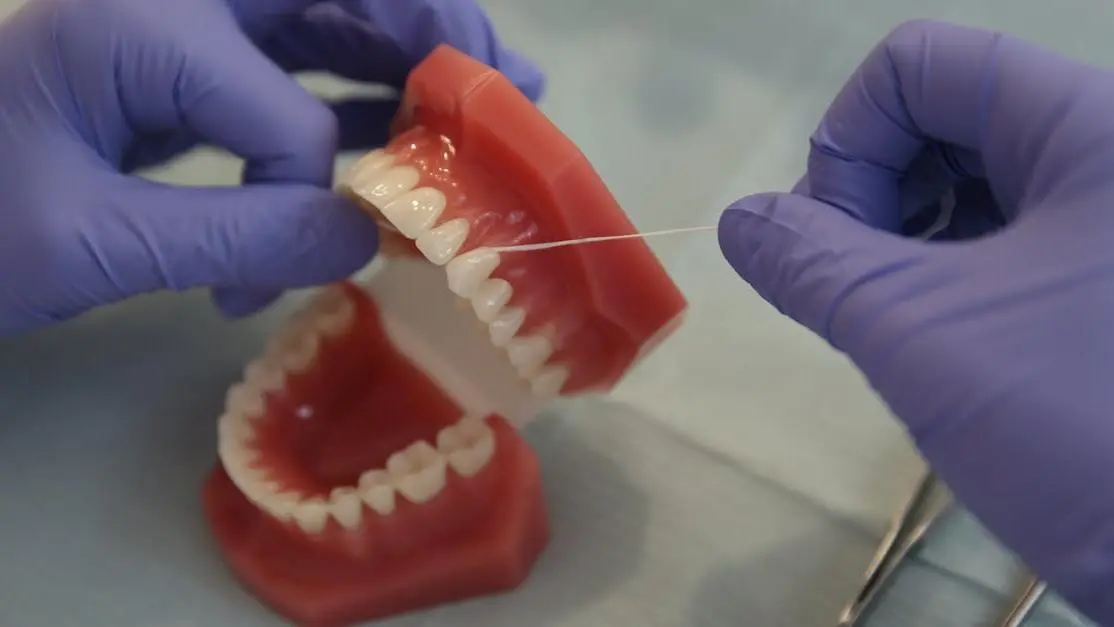Struggling with food stuck between teeth removal is a common frustration, often leading to discomfort and embarrassment.
It can happen to anyone and understanding how to manage it effectively is crucial. We've prepared a guide to ease your concerns, featuring:
- Simple techniques for food stuck between teeth removal.
- Insights on why food gets trapped and its impact on your oral health.
- Modern solutions offered by Cookstown Dental, ensuring painless care.
Why Food Gets Stuck Between Your Teeth
Have you ever wondered why food particles seem to love hiding out between your teeth? You're not alone. This little annoyance can stem from various factors, each with its own impact on your dental health.
- Spacing Issues: Small gaps between your teeth and spaces created by dental treatments (like braces, crowns, or fillings) can become prime spots for food to sneak in and settle.
- Gum Health: Conditions like gum disease may create pockets around the teeth, inviting food to camp out. Healthy gums should lie snug against the teeth, reducing food's ability to get lodged.
- Types of Foods: Corn on the cob, popcorn, and meat are notorious for getting stuck. Their consistency and shape can challenge even the savviest of eaters.
- Dental Alignments: Misaligned or overcrowded teeth make a perfect setting for compacted food. Regular check-ups can help identify any needed adjustments or treatments.
At Cookstown Dental, we understand the irritation and potential problems that stuck food brings. It’s not just about the inconvenience—it can lead to plaque buildup and, ultimately, more serious dental issues. Our goal is to help you manage these challenges with professional care and guidance.
How to Use Dental Floss for Safe Removal
If you've found yourself in a battle with a persistent piece of food, flossing might be your best ally. Here’s how you can master this technique effectively:
- Start with Enough Floss: Draw about 18 inches of floss from your dispenser. This might sound like a lot, but it gives you a fresh section of floss for each tooth.
- Gentle Motion: Gently thread the floss between your teeth and carefully work it up and down. Form a C-shape against the tooth to hug the curve and slide beneath the gum line.
- No Snapping: Avoid snapping the floss into your gums. Instead, use a gentle sawing motion to guide it. Your gums are sensitive, and snapping can cause injury and discomfort.
- Repeat: Move to a clean section of floss for each tooth space to avoid transferring food particles.
Types of Floss: For narrow spaces, you might prefer waxed floss, which glides smoothly. If your gaps are a bit wider, dental tape offers a broader cleaning surface. The key is to find what works most comfortably for you.
Alternative Tools for Food Removal
Sometimes, floss just doesn’t cut it. That’s where other tools come into play, offering tailored solutions for your specific needs.
- Interdental Brushes: These are small brushes designed to fit between the teeth and are excellent for cleaning around braces and bridges. They're thin enough to reach tight spaces and effective in removing food particles.
- Water Flossers: Devices like Waterpik use a jet of pulsating water to cleanse between teeth and gums. They're perfect for braces wearers, reaching places that traditional floss can't.
- Toothpicks and Dental Picks: Toothpicks can be handy but be cautious not to exert too much pressure; opting for dental picks specifically designed for teeth can offer a safer alternative. Ensure they are soft to prevent damaging the gums.
Whichever tool you choose, consistency is key to maintaining oral health and preventing trapped food from leading to plaque buildup.
When to Seek Help from a Dentist
Knowing when to call in professional help is crucial for maintaining a smile that’s as bright as it is healthy.
There are times when the usual DIY methods might not suffice, especially when dealing with persistent or painful problems.
- Recurring Issues: If food consistently gets trapped in the same spots, it may be an indicator of an underlying issue, like cavities or collapsed fillings, that needs addressing.
- Pain or Discomfort: Experiencing pain or discomfort when food is stuck is a signal that it might be time to visit our clinic. Ignoring these sensations can lead to deeper issues requiring more intensive treatment.
- Ineffective Home Removal: If the food simply cannot be removed at home, professional intervention can ensure complete and safe removal without damaging your gums or teeth.
At Cookstown Dental, we’re dedicated to providing you with painless and effective care to resolve your dental concerns. Don't hesitate to reach out for help when you need it. Your dental health is our priority, and we aim to keep your experience as comfortable and stress-free as possible.
Prevention Tips to Minimize Food Entrapment
Let's face it, the best way to handle food stuck between teeth removal is to prevent it from happening in the first place. By integrating a few simple habits into your daily routine, you can reduce the likelihood of food getting stuck and keep your mouth healthy and comfortable.
- Maintain Regular Oral Hygiene: Brushing twice daily and flossing at least once can significantly reduce debris build-up. Make sure to brush for at least two minutes, focusing on reaching all areas of the mouth.
- Use the Right Products: Consider using an antiseptic mouthwash or a fluoride mouth rinse. These products help kill bacteria and strengthen teeth, ensuring that food particles don't linger.
- Optimize Your Diet: Choose foods that promote oral health and minimize the likelihood of getting stuck. Opt for fibrous fruits and vegetables over sticky, fibrous foods that tend to lodge between teeth.
- Monitor Portion Sizes: Large bites or quick meals often lead to poor chewing, which can contribute to food entrapment. Eating smaller, well-chewed bites can improve digestion and reduce complications.
- Routine Dental Visits: Maintain regular dental check-ups to identify any alignment, spacing, or restorative issues that might contribute to food lodgement.
Our goal at Cookstown Dental is to empower you with both preventive strategies and professional care when needed. Through preventive habits, you can enjoy more meals without interruptions, securing healthier teeth and gums in the process.
Common Missteps and What to Avoid
Navigating the removal of food stuck between teeth requires a bit of know-how. Avoiding common mistakes can prevent further dental issues and keep your smile bright.
- Avoid Using Sharp Objects: Using items like pins, knives, or scissors to dislodge food is dangerous and can damage teeth and gums. Stick to dental-safe tools instead.
- Don’t Skip Flossing: Flossing should never be skipped or rushed. It’s an essential step in maintaining oral hygiene and ensuring food doesn’t have a chance to cause troubles.
- Improper Tool Use: Using floss or picks incorrectly can harm gums. Practice gentle, strategic use of these tools to ensure effectiveness without injury.
- Ignoring Persistent Problems: Don’t underestimate the importance of addressing recurring food lodgement. If you face a persistent problem, consulting a dental professional should be your next step.
Remember, brushing the right way and using appropriate dental tools can prevent potential missteps. At Cookstown Dental, we prioritize your comfort and aim to keep you informed about the best practices for maintaining oral health.
Cookstown Dental’s Approach to Painless Dentistry
At Cookstown Dental, we aim to make every visit as comfortable as possible, especially when it comes to food stuck between teeth removal. Our approach is rooted in providing an environment that's welcoming and anxiety-free.
- Patient-Centered Care: We take the time to understand your needs and concerns, offering personalized treatment plans that cater to your specific requirements.
- Advanced Technology: Utilizing the latest dental technologies, we ensure that procedures are efficient, precise, and gentle. From digital x-rays to state-of-the-art treatment tools, we prioritize quality care.
- Pain-Free Techniques: Our team is skilled in modern anesthetics and sedation options, if needed, ensuring that all our procedures can be as pain-free and relaxing as possible.
- Comprehensive Education: We believe in the power of knowledge. By educating our patients about preventive care and effective home dental practices, we empower you to maintain better oral health on your own.
Visiting Cookstown Dental is not just about addressing dental issues—it's about enhancing your overall well-being in a supportive atmosphere. We’re committed to making sure every experience is seamless and stress-free.
Conclusion
Managing food stuck between teeth doesn't have to be an ordeal. By employing effective removal techniques and preventive measures, you can maintain your oral health and comfort. At Cookstown Dental, we provide personalized, pain-free care that prioritizes your needs and upholds our commitment to exceptional dental experiences.
Whether you're dealing with a minor inconvenience or a recurring issue, our team is here to help guide you toward a healthier, more confident smile. Ready to make the switch to more comfortable dental care? Visit Cookstown Dental for skilled, compassionate service you can trust.

